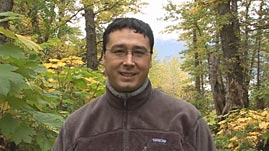Teachers' Domain - Digital Media for the Classroom and Professional Development
User: Preview

Source: Produced for Teachers' Domain
This video produced for Teachers' Domain profiles Steve MacLean, an Iñupiaq scientist who works for The Nature Conservancy. In his role as a conservationist, MacLean works to preserve biodiversity in the Bering Sea, a unique marine environment being threatened by climate change. Brought up in the Alaska Native ways of knowing, he explains that Alaskan cultures are intimately connected with nature and suggests that people should not be separated from natural systems when considering solutions to environmental issues. MacLean strongly recommends a career in science for Alaska Native peoples interested in making a difference where they live.
The Bering Sea is one of the most productive marine ecosystems on Earth and home to numerous species of marine animals and sea birds. Yet today, this highly diverse and productive environment is threatened. Steve MacLean, an Iñupiaq scientist, is the Bering Sea Program director for The Nature Conservancy in Alaska. This organization works to preserve the plants and animals that represent the biodiversity of life on Earth.
In the face of climate change, scientists like MacLean are hoping to understand how global warming will change the ecosystem. Which mammals, birds, and fish will survive if the seasonal ice of the Bering Sea melts too soon? Which will survive if the multiyear ice in the Arctic that should remain frozen year-round melts? Which will be forced to leave the region? What new species will move in and take their place? And how might these changes affect Alaska Native communities adjacent to the Bering Sea and along the rivers that discharge into it?
As an Iñupiaq, MacLean was educated in the traditional knowledge and ways of his people—also referred to as the Alaska Native ways of knowing. Based on this knowledge, he sees an intimate connection between Alaska Native cultures and nature—one that influences his approach to his work as a conservationist. For example, both seasonal and multiyear sea ice provide an essential habitat for marine mammals and stimulate food productivity for fish and wildlife. But they also provide subsistence, cultural, nutritional, spiritual, and commercial needs for Alaska Native and other indigenous communities. Because of this and other connections, MacLean believes scientists should not separate people from natural systems in their research and recommendations. Instead, they should treat people as part of the natural systems.
In the following passage, MacLean explains how his unique perspective influences his work and explains why other Alaska Native peoples might consider a career in the sciences:
"In Alaska, we try to remember that Native cultures have been part of the biodiversity and part of the natural landscape for thousands of years. In the Inuit way of knowing, the connectedness of nature is important. I try to keep those connections in mind as I develop conservation strategies and priorities for the Bering Sea and polar marine systems.
"I believe that the sciences offer one of the most personally rewarding career choices available. The challenge of understanding the natural world—and in the case of conservation, applying that knowledge to protect the natural world—is exhilarating. In Alaska today, much effort is spent trying to incorporate traditional knowledge into scientific design. Alaska Native scientists who already are familiar with those perspectives have a great opportunity to contribute much to the modern understanding of our natural systems."
 Loading Standards
Loading Standards Teachers' Domain is proud to be a Pathways portal to the National Science Digital Library.
Teachers' Domain is proud to be a Pathways portal to the National Science Digital Library.
